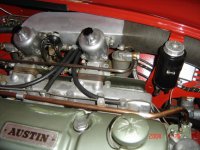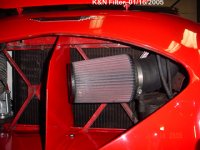Ajax,
I think you would need 2.5" dia. hoses to get enough air flow. Since there would be no useful ram effect at speeds below 120 mph, a high pressure location would not help much & ram effect would present it's own mixture change problems. Better to locate the intakes in a convenient but cool location & not worry about ram effect.
Georg,
I tried the DW filter in the recommended location. As you will note, with the filter stuffed inside a 4 1/2" diameter hose, the larger diameter portions of the filter are blocked by the hose walls. After several tries, to verify, there was just so much air flow restriction that the engine became increasingly choked & would not run above 5,000 rpm.
Another fellow placed the DW filter inside the front end of the hose & claims it worked. I contacted DW & he said that the filter would not flow enough air to support more than 150 HP. I suspect from experience, that the true number is well below 150 HP, due to the previously mentioned hose wall blocking of a good portion of the filter outer diameter.
I used a K&N #RU-2590 filter on the front end of the hose & it works very well. See attached pic.
On the BN1, BN2, it's very easy to replace the top five grill retaining nuts with wing nuts. You can reach in through the wheel wells & remove the nuts, the grill hinges out on it's bottom pegs, & can be removed for very easy filter service.
D

 Hi Guest!
Hi Guest!

 smilie in place of the real @
smilie in place of the real @
 Pretty Please - add it to our Events forum(s) and add to the calendar! >>
Pretty Please - add it to our Events forum(s) and add to the calendar! >> 



